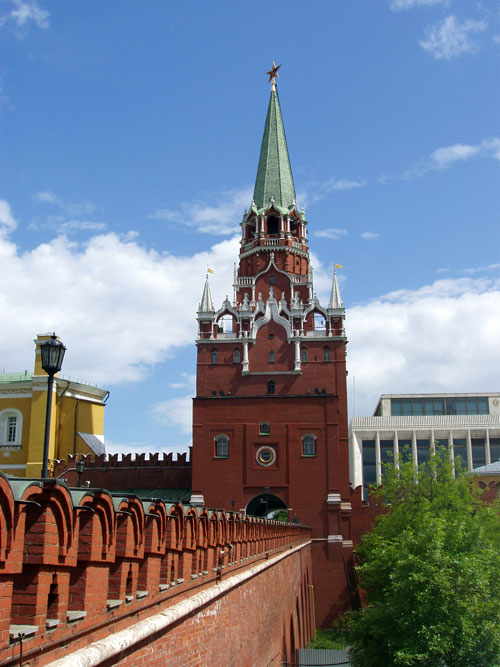|
Sobir Odilov
Sobir Rahimovich Odilov ( born March 1, 1932, Tashkent – July 18, 2002, Tashkent) was an Uzbek and Soviet architect. He was awarded the title of People's Architect of the USSR in 1981 and served as the Chief Architect of Tashkent from 1970 to 1986. He was also a laureate of the State Prize of the USSR in 1975. Biography He was born on 1 March in Tashkent,1932. After graduating from the architectural department of the Central Asian Polytechnic Institute (now Tashkent State Technical University) in 1955, he worked as the Chief Architect of Almalyk (1955–1961) and the Tashkent Region of Uzbekistan (1962–1966). Later, he served as the Chief Architect of Tashkent (1970–1984, 1990–1991). He also held the position of Deputy Chairman of the Committee for Construction of the Uzbek SSR (1975–1985, 1990–1991) headed the department (1986), and later served as the director (1989) of the Uzbek Scientific Research and Design Institute for the Restoration of Cultural Monuments. ... [...More Info...] [...Related Items...] OR: [Wikipedia] [Google] [Baidu] |
Tashkent
Tashkent (), also known as Toshkent, is the Capital city, capital and List of cities in Uzbekistan, largest city of Uzbekistan. It is the most populous city in Central Asia, with a population of more than 3 million people as of April 1, 2024. It is located in northeastern Uzbekistan, near the border with Kazakhstan. Before the influence of Islam in the mid-8th century AD, Sogdian people, Sogdian and Turkic people, Turkic culture was predominant. After Genghis Khan destroyed the city in 1219, it was rebuilt and profited from its location on the Silk Road. From the 18th to the 19th centuries, the city became an Tashkent (1784), independent city-state, before being re-conquered by the Khanate of Kokand. In 1865, Tashkent fell to the Russian Empire; as a result, it became the capital of Russian Turkestan. In Soviet Union, Soviet times, it witnessed major growth and demographic changes due to Population transfer in the Soviet Union, forced deportations from throughout the Soviet Unio ... [...More Info...] [...Related Items...] OR: [Wikipedia] [Google] [Baidu] |
People's Architect Of The USSR
People's Architect of the USSR (), also sometimes translated as National Architect of the USSR, was an honorary title granted to architects of the Soviet Union; it was established on August 12, 1967 by Leonid Brezhnev. It was bestowed by the Presidium of the Supreme Soviet of the USSR owing proposals addressed by the ''State Construction Committee'' or by the ''Soviet Architects' Union''. The Supreme Soviet could possibly refuse these designations. A diploma of the Supreme Soviet's presidency was given to those who were appointed ''People's Architect of the USSR'' jointly with the medal and its concerning certificate. The title was bestowed upon architects who had achieved significant results in Soviet architecture's development either applying their expertise and creativity to the urban planning or to the design of important building compounds for civil, industrial or rural use. Following the Dissolution of the Soviet Union (1991), by a decree of the Russian presidency, it was ... [...More Info...] [...Related Items...] OR: [Wikipedia] [Google] [Baidu] |
Soviet Architects
This is a list of architects of the Russian Federation, Soviet Union, Russian Empire, Tsardom of Russia and Grand Duchy of Moscow, both ethnic Russians and people of other ethnicities. This list also includes those who were born in the ///Tsardom of Russia/Grand Duchy of Moscow but later emigrated, and those who were born elsewhere but immigrated to the country and/or worked there for a significant period of time. Attested biographies of architects in history of Russia, Russian history date back to 1475, when Aristotile Fioravanti, a native of Bologna, arrived in Moscow to build the Dormition Cathedral, Moscow, Dormition Cathedral of the Moscow Kremlin. Foreign architects had a notable place in Russian and Soviet Union, Soviet history, especially in the last quarter of the 18th century (Charles Cameron (architect), Charles Cameron, Bartolomeo Rastrelli, Carlo Rossi (architect), Carlo Rossi and others) and in the first quarter of the 20th century (Ludwig Mies van der Rohe, Mies van d ... [...More Info...] [...Related Items...] OR: [Wikipedia] [Google] [Baidu] |
2002 Deaths
This is a list of lists of deaths of notable people, organized by year. New deaths articles are added to their respective month (e.g., Deaths in ) and then linked below. 2025 2024 2023 2022 2021 2020 2019 2018 2017 2016 2015 2014 2013 2012 2011 2010 2009 2008 2007 2006 2005 2004 2003 2002 2001 2000 1999 1998 1997 1996 1995 1994 1993 1992 1991 1990 1989 1988 1987 1986 Earlier years ''Deaths in years earlier than this can usually be found in the main articles of the years.'' See also * Lists of deaths by day * Deaths by year (category) {{DEFAULTSORT:deaths by year ... [...More Info...] [...Related Items...] OR: [Wikipedia] [Google] [Baidu] |
1932 Births
Events January * January 4 – The British authorities in India arrest and intern Mahatma Gandhi and Vallabhbhai Patel. * January 9 – Sakuradamon Incident (1932), Sakuradamon Incident: Korean nationalist Lee Bong-chang fails in his effort to assassinate Emperor Hirohito of Japan. The Kuomintang's official newspaper runs an editorial expressing regret that the attempt failed, which is used by the Japanese as a pretext to attack Shanghai later in the month. * January 22 – The 1932 Salvadoran peasant uprising begins; it is suppressed by the government of Maximiliano Hernández Martínez. * January 24 – Marshal Pietro Badoglio declares the end of Libyan resistance. * January 26 – British submarine aircraft carrier sinks with the loss of all 60 onboard on exercise in Lyme Bay in the English Channel. * January 28 – January 28 incident: Conflict between Japan and China in Shanghai. * January 31 – Japanese warships arrive in Nanking. February * February 2 ** A general ... [...More Info...] [...Related Items...] OR: [Wikipedia] [Google] [Baidu] |
Anvar Kurbanov
Anvar Kurbanov (Uzbek: Qurbonov Anvar Sarmanovich; born 1948) is an Uzbek builder, craftsman, and brigade leader of the Mobile Mechanized Column No. 49 of the "Sir daryojamqurilish" State Enterprise in the Sirdaryo Region. In 1998, he was awarded the title of Hero of Uzbekistan. Biography Anvar Kurbanov was born in 1948 in the Guliston District of the Uzbek Soviet Socialist Republic. In 1969, he began his work as a mason in the construction company No. 60 in the Guliston District. Since 1975, he has been working as a construction master in the third mechanized column of the same district. From 1981 to 1998, he held the position of brigade chief of the mechanized column No. 49 at "Sir Daryo Jamqurilish." In 1998, he was appointed brigade chief of the SMU No. 4 in the Guliston District. In 2000, he was elected chairman of the trade union of this organization. Anvar Kurbanov actively participated in the construction of many major architectural structures, such as the 5th district o ... [...More Info...] [...Related Items...] OR: [Wikipedia] [Google] [Baidu] |
Zarema Nagayeva
Zarema Sodiqovna Nagayeva (; born August 30, 1949, in Tashkent) is a Soviet, Uzbek, Ukrainian, and Russian architect. She holds a doctorate in architecture and is a professor. She has been a member of the Russian Union of Architects since 1977. Early life She was born in Tashkent on August 30, 1949. She spent her childhood in the Uzbek SSR. Her father was an architect, Sodiq Nagayev. She completed her studies at the Faculty of Architecture of Tashkent Polytechnic Institute in 1972. In 1988, she defended her candidate's dissertation on the topic "Functional and Planning Organization of Services to the Population in Central Cities and Districts (on the Example of Uzbekistan's Cities)" and in 1998, she defended her doctoral dissertation on the topic "Urban Planning Organization in Providing Public Services to the Population of Uzbekistan". From 1970 to 1990, she worked at the Institute of Urban Planning Research in Uzbekistan. Simultaneously, she worked at Tashkent Polytechnic I ... [...More Info...] [...Related Items...] OR: [Wikipedia] [Google] [Baidu] |
Sergo Sutyagin
Sergo Sutyagin (Russian: Серго Михайлович Сутягин) (February 23, 1937, Moscow – July 28, 2021, Tashkent) was an Uzbekistani architect. He was a laureate of the State Prize of the Uzbek SSR named after Hamza in 1966, as well as the State Prize of the Republic of Uzbekistan in the field of literature, art, and architecture named after Alisher Navoi, along with other awards. Biography He was born on February 23, 1937, in Moscow, into an engineer's family. During the war, he was evacuated to the Uzbek SSR, and from 1941 to 1945, he lived with his mother in Samarkand. In 1946, he moved to Tashkent. From 1954 to 1960, he studied at the Central Asian Polytechnic Institute (now Tashkent State Technical University) and graduated from the architectural department of the construction faculty in 1960. In the same year, he began working at the design institute Uzgosproekt (since 1972 – UzNIIP of Urban Planning, currently – UzShaharsozlik LITI). He worked in the posi ... [...More Info...] [...Related Items...] OR: [Wikipedia] [Google] [Baidu] |
Order Of Friendship Of Peoples
The Order of Friendship of Peoples () was an order of the Soviet Union, and was awarded to persons (including non-citizens), organizations, enterprises, military units, as well as administrative subdivisions of the USSR for accomplishments in strengthening of inter-ethnic and international friendship and cooperation, for economical, political, scientific, military, and cultural development of the Soviet Union. It was established on December 17, 1972, on the occasion of the 50th anniversary of the creation of the Soviet Union. The design of order was created by . The status of Order was slightly amended by the Supreme Council of the Soviet Union in July 1980. It was abolished in December 1991. In the Russian Federation it was succeeded by the Order of Friendship, also designed by Alexander Zhuk. The first recipient was the Russian Soviet Federative Socialist Republic (RSFSR), followed by the other republics of the Soviet Union. See also *Order of Friendship *Lenin Peace Priz ... [...More Info...] [...Related Items...] OR: [Wikipedia] [Google] [Baidu] |
USSR State Prize
The USSR State Prize () was one of the Soviet Union’s highest civilian honours, awarded from its establishment in September 1966 until the dissolution of the USSR in 1991. It recognised outstanding contributions in the fields of science, mathematics, literature, the arts, and architecture. History State Stalin Prize (1941–1956) The award traces its origins to the State Stalin Prize (), commonly known as the Stalin Prize, which was established in 1941. It honoured achievements in science, technology, literature, and the arts deemed vital to the Soviet war effort and postwar reconstruction.Volkov, Solomon; Bouis, Antonina W., trans. 2004. ''Shostakovich and Stalin: The Extraordinary Relationship Between the Great Composer and the Brutal Dictator''. New York: Alfred A. Knopf. ISBN 0-375-41082-1. Ceremonies were suspended during 1944–45 and then held twice in 1946 (January for works from 1943–44; June for 1945 works). USSR State Prize (1966–1991) By 1966, the Stalin Prize h ... [...More Info...] [...Related Items...] OR: [Wikipedia] [Google] [Baidu] |



